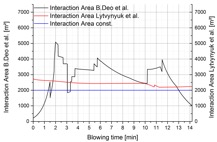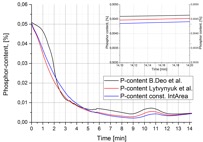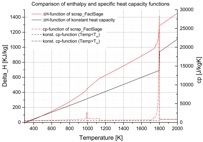The basic development of a thermodynamic and kinetic model of the converter steelmaking was completed by the predecessor Mag.Dr.mont. Y. Lytvynyuk in Phase I and II of the K1-Met. The first test calculations with the model showed qualitatively fair results considering the time trend for the bath temperature as well as concentration of elements in the metal bath and slag components. Further model improvements are related to the kinetic part of the model. A more realistic description of the interaction area between slag and metal is under development and will be verified by slag sample investigations. The effect of iron droplet formation during the blowing process is included in the calculation of the reaction area (Fig.1).
Fig.1: Comparison of different interaction area approaches (left) and the influence on the trajectory of the phosphorus in the metal phase
Alternative model correlation for the bath agitation which is controlling the interfacial metal slag reaction will be tested and if necessary implemented. In order to adjust the model results with actual operation data from industrial plant model tuning parameters have to be modified. The objective within this project is the further verification and improvement of this model. The aim is to reduce the number of necessary tuning parameters and to develop look up tables for these parameters which are fitted by operation data. The sub-models of the metallurgical reactions should be further developed. Further a verification of the currently used thermodynamic data (e.g. heat capacities) is under progress. The effect of different cp-functions on the calculation demonstrates Fig.2.
Fig.2: Comparison of different heat capacity functions (left) and the influence on the trajectory of the carbon, phosphorus and manganese content in the metal phase
The research work on converter slag should be continued from Phase II of K1-Met where the basic understanding for the dissolution kinetic for CaO and MgO was elucidated. The objective of this project is the development of strategies to minimize the refractory wear on one hand and to optimize the metallurgical results with regard to Fe yield, P and Mn partition, end C content and tapping temperature for a converter heat on the other hand. A new methodology for the evaluation of the properties of slag additives should be developed. The objective is a standardized method for the quality control of converter additives which reflects the process conditions in the converter. Project includes development of experimental technique and application of kinetic models to calculate kinetic parameters of the process as well as verification of kinetic model.






